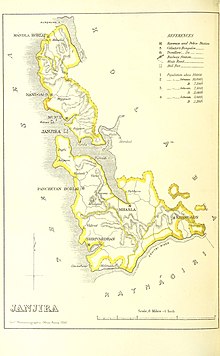Janjira State
Princely state of India From Wikipedia, the free encyclopedia
Princely state of India From Wikipedia, the free encyclopedia
Janjira State was a princely state in India during the British Raj.[1] It was governed by the Siddi Khan dynasty of Habesha descent[1] and the state was under the suzerainty of the Bombay Presidency.
| Janjira State जंजीरा रियासत | |||||||
|---|---|---|---|---|---|---|---|
| Princely State of British India In union with Jafrabad (1759–1948) | |||||||
| 1489–1948 | |||||||
|
Flag | |||||||
 Janjira State, 1896 | |||||||
| Area | |||||||
• 1931 | 839 km2 (324 sq mi) | ||||||
| Population | |||||||
• 1931 | 110,389 | ||||||
| History | |||||||
• Established | 1489 | ||||||
| 1948 | |||||||
| |||||||
| Today part of | Maharashtra, India | ||||||



Janjira State was located on the Konkan coast in the present-day Raigad district of Maharashtra. The state included the towns of Murud and Shrivardhan, as well as the fortified island of Murud-Janjira, just off the coastal village of Murud, which was the capital and the residence of the rulers. The state had an area of 839 km2, not counting Jafarabad, and a population of 110,389 inhabitants in 1931. Jafarabad State (also spelled Jafrabad) was a dependency of the Nawab of Janjira State, and located 320 km to its north-northwest.
According to legend, Janjira Invaded in the year 1489 the Ahmadnagar Sultanate sent its admiral Piram Khan (of Ethiopian descent) with orders to capture the Murud-Janjira from Ram Patil. Owing to the castle's fortifications, Khan could not attack conventionally.
He and his team disguised themselves as merchants and asked Ram Patil to safeguard their three hundred large boxes containing silks and wines from Surat. As thanks, Piram Khan threw a party with wine. Once Ram Patil and his soldiers were intoxicated, Piram Khan opened the boxes, which contained his soldiers, and used the opportunity to capture the castle and the island on which it stands.[2][3][4][5][6][7]
In the century that followed the rulers put themselves under the overlordship of the Sultanate of Bijapur. During the seventeenth and eighteenth century Janjira successfully resisted the repeated attacks of the Maratha Empire.
According to Ottoman records, a combined force from the Ottomans and Janjira mariners routed a Portuguese fleet in 1587 at Yemen.[8] From this moment onwards Janjira played an important role in resisting Portuguese influence in the region.[9]
There's further record of Cooperation with the Ottoman Empire when the Ottoman fleet first arrived in Aceh prior to Ottoman expedition to Aceh has included 200 Malabar sailors from Janjira State to aid the region Batak and the Maritime Southeast Asia in 1539.[10]
According to one records at one time Mughal emperor Aurangzeb supplied the Siddis of Janjira state with 2,000 men, provisions, ammunitions along with two Frigates and two large Man-of-war battleships. The ship arrived at Bombay harbor under the commands of Siddi Kasim and Siddi Sambal in 1677.[11] The largest Mughal ship named Ganj-I-Sawai (Trading Ship) which was equipped with 800 guns and 400 musketeer type soldiers also stationed in the port of Surat.[12]
Another record from an East India Company factory[which?] written 1673 reported the Siddi fleet which wintered from Bombay had five Frigates, two Man-of-wars, and fifteen Grabs. It was because the formidable naval warfare skills of the Siddis in Janjira that Aurangzeb was granting an annual payment of 400.000 Rupees for the maintenance of their fleet.[citation needed]
The main competitor of the Sidis was the Angrias, a Maratha family with sea forts and ships, based in southern Konkan.[13]
In 1733, Peshwa Bajirao of the Maratha Empire launched a campaign against the Siddis of Janjira. Bajirao's forces, however, did not take Janjira fort, though they captured much of the surrounding area; a favorable treaty gave the Marathas some indirect control over virtually all of the Siddi's lands.[13] According to the treaty, the Peshwa acknowledged Abdul Rehman as the 'legitimate ruler' of Janjira, bringing an end to all opposition to his succession by his rivals. The territorial holdings of the Siddi were restricted to Anjanwel and Gowalkot, along with the island of Janjira. All other territories on the mainland, previously liberated by the Marathas from Siddi control, including Raigarh, Rewas, Thal, Chaul, etc., were recognized by Abdul Rehman as integral parts of the Maratha state and off-limits to the Siddis.[14]
When the British came to the Konkan area, the repeated attacks of the Marathas against Janjira ceased. Janjira State was administered as part of the Deccan States Agency of the Bombay Presidency, founded in 1799. In the nineteenth century the rulers maintained a military force of 123 men.[15]
Following the independence of India in 1947, the state was merged with India.
The royal family of Janjira were Siddis, also known as 'Habshi', assumed to be from Abyssinia. Initially the rulers of the state held the title of 'wazir', but after 1803 the title of 'nawab' was officially recognized by the British Raj. They were entitled to an 11 gun salute by the British authorities after the 1903 Coronation Durbar.[16][17]
Seamless Wikipedia browsing. On steroids.
Every time you click a link to Wikipedia, Wiktionary or Wikiquote in your browser's search results, it will show the modern Wikiwand interface.
Wikiwand extension is a five stars, simple, with minimum permission required to keep your browsing private, safe and transparent.